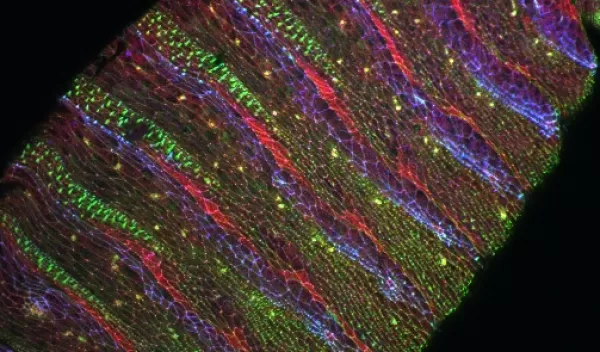
Researcher seeks to identify the pathway that leads to cells forming into an individual body
All organisms begin life as a microscopic cluster of cells. What happens next, as they develop, is a source of endless fascination for scientists.
"How do you go from just a ball of cells into an organism that has a shape, and fingers, toes and brain?" says Traci Stevens, associate professor of biology at Randolph-Macon College. "Cells have to move during development. How do they do it? What is involved? How does that ball of cells become an organized individual?"
Stevens, a National Science Foundation (NSF)-funded scientist is trying to find out, specifically by learning more about the work of Abl, a gene responsible for regulating how cells migrate from that initial tiny collection of cells to form a shape and body parts. "It is a gene we all have, and it seems to work similarly in all organisms," she says.
Specifically, she is focusing on how Abl functions in Drosophila--the fruit fly--which has one Abl gene (humans--in fact, all vertebrates--have two related Abl genes, Abl 1 and Abl 2, whereas invertebrates have only one), making it easier to study. Moreover, "fruit flies have stages in development where we know exactly how the cells move and migrate in normal development," she says.
In her experiments, she activates a mutant form of Abl in the flies to see what happens as the altered gene disrupts the migration pattern. If she can see what goes wrong, she will understand what's supposed to go right. "When I can see what happens with a mutant form, it tells us what is supposed to happen normally," she says. "It seems like reverse logic, but that's how geneticists work."
Her research also involves using a genetic screen to search for other genes that interact with Abl. "We don't know all the details as to how Abl regulates cell migration, but we know Abl doesn't do it by itself, that it works with other proteins," she says.
Her work has potential applications in medicine, specifically for cancer treatment, since Abl "is misregulated in a lot of cancers," she says, adding that its dysfunction has an impact both on cell growth and how cancer cells metastasize. The gene is known to have a role in Chronic Myeloid Leukemia (CML), one of several types of leukemia, as well as in breast cancer, non small lung cancer and melanoma, she says.
To be sure, "we are many steps away, but by identifying not just Abl, but the things it interacts with, by understanding that pathway, it could help us control that pathway," she says. Ultimately, this could lead to the design of new drugs "that could inhibit or regulate this pathway in cases of cancer," she says.
She is conducting her research under an NSF Faculty Early Career Development (CAREER) award, which she received in 2009 as part of NSF's American Recovery and Reinvestment Act. The award supports junior faculty who exemplify the role of teacher-scholars through outstanding research, excellent education and the integration of education and research within the context of the mission of their organization. NSF is funding her work with $883,365 over four years.
As part of the grant's educational component, Stevens hosts two high school students and their biology teacher in her lab during the summer. They attend Cosby High School, a science-based high school in Chesterfield, Va. "They come into the lab for five weeks and work on a project or two," she says. "Then at the end of the summer, they present a poster at a college-wide conference."
Stevens is especially proud that one of the participating teachers had an opportunity to present her work at a national Drosophila meeting. "That was a great experience for her," Stevens says.
Stevens is studying Abl's role in two specific stages of fruit fly development. The first, the formation of the epithelium, or skin of the embryo, a process known as dorsal closure, where "there is a big opening on the skin and the cells migrate to close all the way around the embryo," she says. The second, head involution, is when "the inside of the head is on the outside, and those cells migrate inward to form the head," she explains.
"Those are the two stages we study," she adds. "They are both happening at nearly the same time, but at different places. They occur the first day you have a fertilized egg, before it hatches into a larva. So we are looking at the very beginning. We analyze their phenotypes, that is, we look at what developmental processes did not occur properly. For example, are there holes in the head indicating that head involution did not occur properly? Or are there holes in the dorsal surface indicating that there were cell migration problems during dorsal closure?"
In fruit flies, the Abl protein, which is made from the Abl gene, is found in the cytoplasm of the cell just under the cell membrane, where it can control cell migration, rather than in the nucleus, where it could regulate cell division.
In humans, and other vertebrates, Abl 2 is in the cytoplasm, as it is with fruit flies, but Abl 1 "shuttles back and forth between the nucleus and the cytoplasm," she says. "So Abl 1 binds to DNA in the nucleus and controls cell division, which Abl in Drosophila and Abl 2 in humans don't seem to do."
Scientists don't yet understand how the duties are divided between the two Abls in vertebrates and/or whether the two vertebrate genes might play unique roles, that is, roles that Drosophila Abl does not, according to Stevens.
Thus, "the fruit fly can't tell us everything," she says. "But it can tell us how the gene influences how cells move, and that can tell us something about what happens in humans since that is a function conserved in both fruit flies and humans."
